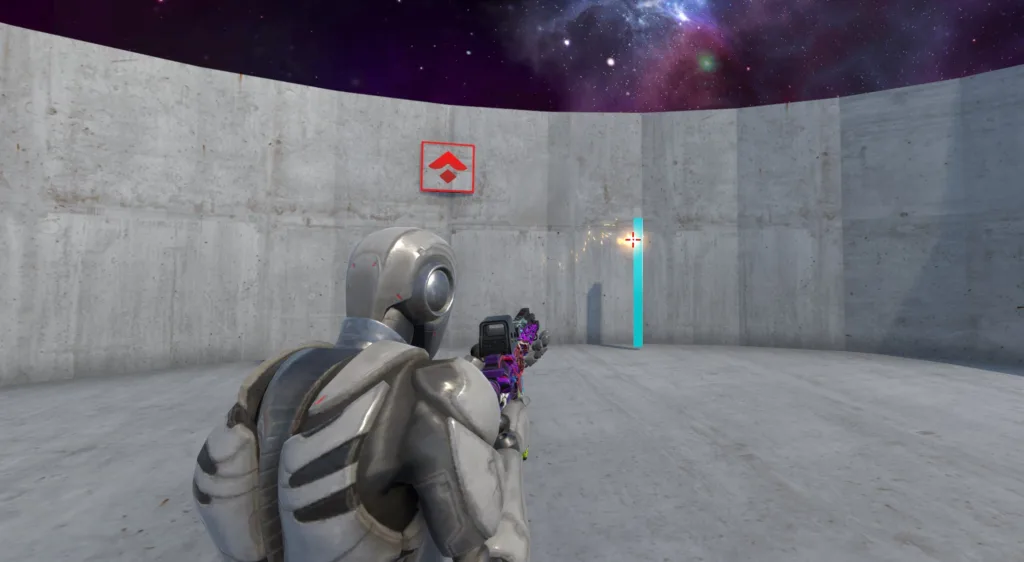
How to Master Your Aim in Fortnite!
Whether you are new to Fortnite, or you are coming back after a long break, this training plan will help you hone the essential skills needed for excelling in the game, particularly focusing on improving your gunplay. It’s designed to help you understand and practice the mechanics that are going to be needed to elevate your Fortnite aim.
Our training is divided into the three main aiming categories: Flicking, Tracking, and Target Switching, prefaced by a primer exercise for smoothness. Each of these subsets will play a critical role in enhancing your aim in Fortnite. While our trainer may not directly replicate Fortnite’s unique building mechanics, it will strengthen your overall combat skills, preparing you for a wide variety of in-game scenarios. Make sure to check out our custom Aimlabs maps in Fortnite for more unique challenges!

Keeping Your Aim Steady Under Pressure
Our first focus of this quickstart guide will be on smoothness, which is essential in aiming across any shooter. Smoothness means moving your crosshair in a fluid motion without jitter. Often, as you move your mouse, you may notice that your crosshair is skipping across the screen as opposed to moving fluidly.
In shooters, especially those with a higher TTK (Time To Kill) like Fortnite, smoothness becomes a crucial aspect of combat. These games require you to track targets for extended periods in order to maximize damage output. Effective tracking and smoothness are tied to one another; any inconsistency can lead to missed shots and reduced damage. Given Fortnite’s high TTK, maintaining smoothness can significantly impact the outcome of your aim duels.
This task will help you develop a solid foundation in smoothness and warm your hand up for the rest of the exercises in our plan.
Fast and Accurate Flicks
Now, let’s explore how core aiming mechanics apply to Fortnite, starting with flicking. Flicking is crucial in shooters for the purpose of rapidly adjusting your crosshair to a new target and timing your inputs precisely upon your target aligning with your crosshair.
Although tracking tends to take priority in high TTK games like Fortnite, the game’s unique building mechanics significantly influence its gameplay. Fortnite offers two main modes: the classic mode where building is enabled and the zero build in which it is omitted. In zero build, tracking takes the lead due to frequent open-field engagements.
Conversely, in Fortnite’s standard mode, the ability to quickly build structures like walls and floors alters the combat dynamics significantly. Here, flicking is vital for quickly taking shots during the brief moments in which your opponents are exposed before they can rebuild cover.
Next, we’ll introduce tasks to train your flicking skills, focusing on its two main types: static flicking and dynamic flicking.
Landing Fast Shots on Stationary Targets
The first type of flicking we’ll focus on is static flicking, which is all about aiming at immobile targets. This skill is crucial in any shooter, including Fortnite, where you often encounter scenarios requiring you to target stationary or slow-moving enemies. Some of these situations include instances where opponents are scoped in and standing still, moments in which an enemy’s movement is hindered as they heal, or even the short period in which their player model is exposed following the destruction of their defensive structures.
Getting comfortable with the variety of shotguns available in your arsenal is particularly important in Fortnite due to its unique building dynamics. Box fighting, a common tactic where players build box-like structures to gain the advantage in their duels, highlights the necessity of effective shotgun use. These brief encounters demand quick, precise flicks, especially when exploiting openings in an opponent’s defenses.
Another key Fortnite mechanic that makes use of static flicking is right-hand peeking. This tactic takes advantage of the game’s third-person perspective, allowing players to see opponents from behind cover without exposing themselves. Quick reactions and accurate flicks are essential in capitalizing on these moments.
We will now introduce a set of tasks designed to enhance your static flicking skills, ensuring you understand and can apply these mechanics effectively. The targets will be static, work on speeding up your flicks gradually, more and more as you feel more confident in your accuracy.
Play rA FN Multiclick
Play rA MultiReflex 3P
Play rA Threeshot Narrow 3P
Snapping to Moving Targets
Having explored static flicking, we will now shift our focus to dynamic flicking, a crucial aspect of targeting moving enemies in Fortnite. Unlike static flicking, which involves aiming at fixed point targets, dynamic flicking necessitates constant adjustments to keep up with the fast-paced nature of an opponent’s movement, especially following the addition of sprinting, sliding, and mantling mechanics in Fortnite.
Dynamic flicking is vital for engagements that occur in open spaces or within close-quarters aim duels such as boxfights. During such combat encounters, you will find yourself relying heavily on dynamic flicking, requiring you to make constant adjustments to your aim. This skill allows players to swiftly react to their enemy’s movements, which is crucial for landing accurate shots.
Fortnite’s gunplay, such as the first shot accuracy mechanic that eliminates bloom on the initial shot from certain weapons, further underscores the importance of dynamic flicking. By combining this with precise dynamic flicking, players can maximize their damage output against moving targets, increasing their chances of landing those clean back to back headshots and achieving a victory royale.
The upcoming tasks will further develop your dynamic flicking skills, ensuring a comprehensive grasp of these crucial mechanics. Focus on reacting to the targets movements rather than chasing a perfect prediction. Don’t be afraid to zoom in when possible as it can help get a better read on the target.
Play Fortnite One Pump
Play rA Narrow Bounce Gallery ADS Fortnite
Play rA FN 360 Click
Maintaining Aim on Moving Enemies
While flicking is integral to the game, tracking is also crucial in Fortnite, working on your ability to accurately follow a moving target with your crosshair for extended periods. This skill is essential due to the movement mechanics we mentioned before, like sprinting, sliding, and mantling, which enhance players’ ability to be evasive during combat. Efficient movement is as important as accurate aim, giving you an extra line of defense in hindering an opponent’s ability to land shots on you.
Mastering tracking will not only allow you to consistently land shots on moving targets, it also improves your maneuverability, allowing you to navigate Fortnite’s fast-paced engagements more adeptly. Although Fortnite’s higher TTK and building mechanics often prioritize a combination of skills, tracking remains vital in scenarios like catching opponents in exposed high mobility scenarios, such as using jump pads or gliders, or in the zero build mode, where gunfight dynamics change substantially.
Now, let’s focus on the two main types of tracking: precise tracking and reactive tracking, which will be the subject of our upcoming tasks.
Staying Locked on Small Movements
Precise tracking involves making continuous, small adjustments to your aim, essential for hitting targets that move within small distances. This skill becomes particularly important in long-range gunfights where opponents and their movements appear smaller in perspective, requiring finer control over your mouse movements.
Unlike reactive tracking, which often focuses on broader adjustments, precise tracking primarily relies on micro-adjustments using your wrist and fingers. This finer control keeps your crosshair accurately lined up with targets, even as they move unpredictably or when vertical elements like jump pads or gliders come into play.
Mastering precise tracking is crucial when dealing with skilled opponents in Fortnite who utilize advanced movement techniques, especially in scenarios like zero build mode where building isn’t available. It’s especially vital when aiming at enemies who are jumping or strafing during combat, ensuring that you land your shots during these tricky situations.
The upcoming tasks will focus on honing your precise tracking skills, providing a practical understanding of this critical mechanic. Maintain precise, smooth movements as you track the target, with a focus on smoothness.
Play VT SuaveTrack Novice
Play VT SphereTrack Novice
Play rA BunnyTrack
Reacting to Sudden Target Shifts
Having covered precise tracking, let’s talk about reactive tracking, a form of tracking that focuses on responding quickly to large or abrupt changes in your opponent’s movement. Reactive tracking is crucial in the fast-paced close-quarter nature of engagements in Fortnite. Finer adjustments matter less in these scenarios, with shift, sharp corrections taking the lead.
Fortnite’s dynamic skirmishes, building, and editing heighten the need for reactive tracking. Reactive tracking is often confused with predictive tracking, in which a target’s next movements are “locked” and all you need to do is follow along with your crosshair. Unlike predictive tracking, in which you anticipate where the target will be and aim ahead of its current position, reactive tracking involves constantly reacting to the target’s movements in real time, necessitating quick reactions.
The tasks ahead will focus on improving your ability to adapt to rapid directional changes and enhancing your reactive tracking skills in Fortnite’s ever-changing environment. Remember, react, don’t predict. Stay reactive, read the targets movement and then adjust.
Play VT PillTrack Novice
Play VT GliderTrack
Play rA Fortnite Boxfight
As we conclude our plan’s journey, having broken down the fundamentals of aiming in Fortnite, it is crucial to reflect on the skills we have honed and the knowledge that has been amassed. The intricacies of static versus dynamic flicking, the fine adjustments required in precise tracking, and the swift adjustments that its reactive counterpart necessitate. All these topics have been explored in detail to give you the edge you need on the battlefield.
To ensure the practical application of your newfound understanding of aiming in Fortnite, we’ve weaved playable tasks into this plan to help you strengthen and test these skills. These exercises aren’t just drills; they’re stepping stones to transforming theory into instinct, where every flick, track, and switch becomes a natural extension of your skills and knowledge. Make sure to revisit them often, in order to reinforce what we’ve covered, and then take it out to your next drop in!
